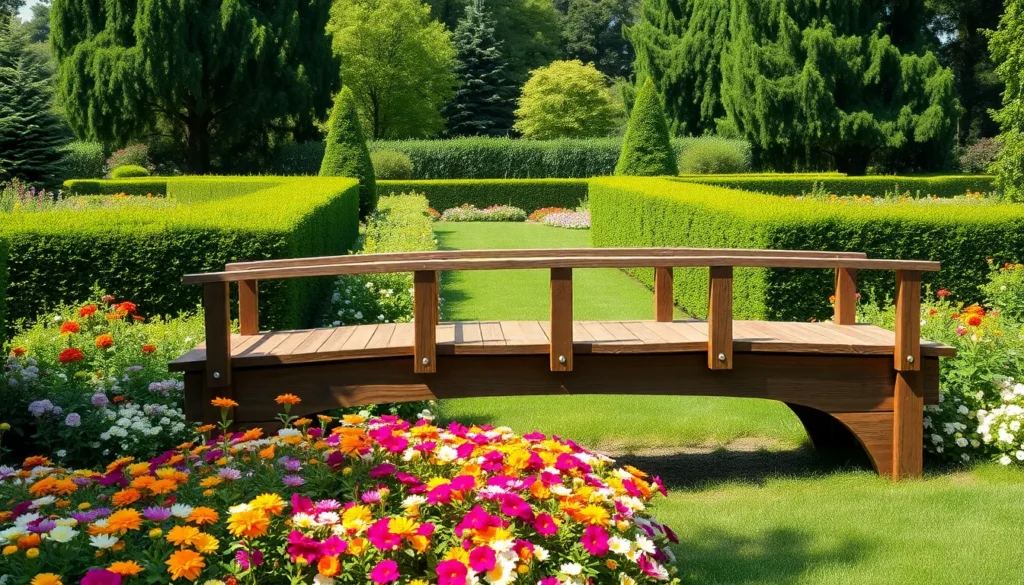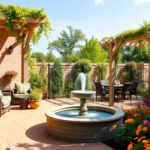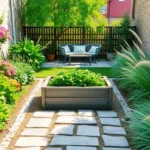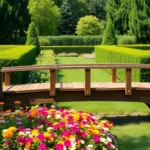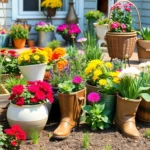We’ve all dreamed of adding that perfect finishing touch to our outdoor space that transforms an ordinary garden into something truly magical. Garden bridges aren’t just functional pathways – they’re stunning focal points that create depth visual interest and a sense of adventure in any industry design.
Whether you’re working with a sprawling backyard or a cozy courtyard we’re here to show you how the right bridge can completely elevate your garden’s aesthetic. From rustic wooden walkways that blend seamlessly with natural surroundings to elegant arched designs that make bold architectural statements there’s a perfect bridge style waiting to complement your unique outdoor vision.
The best part? You don’t need a rushing stream or koi pond to justify adding a garden bridge. We’ll explore creative placement ideas that work beautifully over dry creek beds flower beds or simply as decorative elements that guide visitors through your carefully curated industry masterpiece.
Rustic Wooden Garden Bridge Ideas for Natural Charm
Natural materials create timeless appeal in garden bridge construction. We’ll explore three distinctive wooden options that seamlessly blend functionality with organic beauty.
Reclaimed Barn Wood Bridges
Weathered barn wood brings authentic character to garden pathways. We can construct these bridges using salvaged planks that showcase decades of natural patina and unique grain patterns. The aged texture adds instant rustic charm while providing an eco-friendly solution for outdoor design.
Installation involves creating a sturdy frame using pressure-treated lumber as the foundation. We then attach reclaimed planks as decking, leaving small gaps between boards for drainage. Metal brackets secure the weathered wood to prevent warping while maintaining the authentic appearance.
These bridges work exceptionally well in cottage gardens and farmhouse landscapes. We recommend treating reclaimed wood with clear sealant to preserve its character while protecting against moisture damage. The natural imperfections in barn wood create visual interest that complements wildflower gardens and vegetable plots.
Cedar Log Bridge Designs
Cedar logs offer natural resistance to insects and weather conditions. We can build these bridges using whole logs or split half-logs depending on the desired aesthetic and budget constraints. The aromatic wood releases pleasant scents while requiring minimal maintenance throughout the seasons.
Construction begins with selecting logs of uniform diameter for consistent appearance. We notch the logs at connection points to create stable joints without requiring metal fasteners. This traditional technique ensures the bridge maintains its natural look while providing years of reliable service.
Log bridges complement woodland gardens and natural landscapes perfectly. We suggest using cedar posts as railings to match the decking material and create design continuity. The reddish brown color of cedar weathers to an attractive silver gray over time.
Bamboo Garden Bridge Options
Bamboo provides lightweight strength with rapid growth sustainability. We can source bamboo poles locally in many regions, making this option both affordable and environmentally conscious for garden bridge projects. The hollow structure reduces weight while maintaining impressive load-bearing capacity.
Assembly requires drilling pilot holes to prevent splitting when connecting bamboo sections. We use stainless steel screws and brackets designed specifically for bamboo construction to ensure lasting connections. Flexible bamboo allows for slight movement that accommodates ground settling.
These bridges excel in Asian-inspired gardens and zen landscapes. We recommend applying bamboo-exact preservatives to extend lifespan in outdoor conditions. The natural golden color of bamboo creates stunning contrast against green foliage and water features.
Modern Metal Garden Bridge Designs for Contemporary Spaces
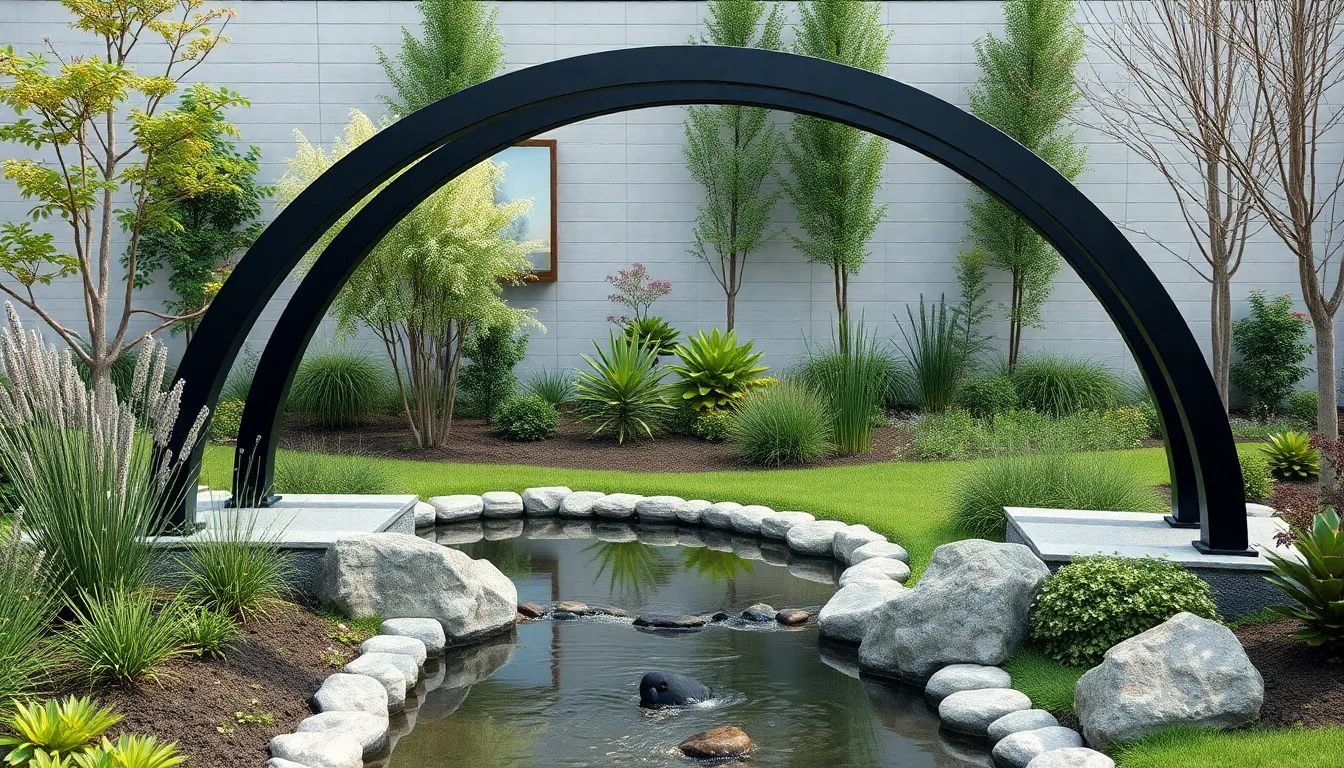
Contemporary gardens call for bridge designs that complement clean lines and minimalist aesthetics. Metal bridges offer the perfect solution for modern outdoor spaces with their sleek profiles and durable construction.
Sleek Steel Arch Bridges
Steel arch bridges deliver sophisticated elegance through their graceful curved designs and powder coated finishes. The 8-Ft Metal Garden Bridge exemplifies this style with its double arched rails crafted from black powder coated steel, creating a striking focal point for contemporary landscapes.
Slatted walking surfaces prevent water accumulation and debris collection, ensuring these bridges maintain their pristine appearance year round. Black powder coating provides superior weather resistance while maintaining the sleek aesthetic that modern gardens demand.
Installation becomes straightforward with pre engineered components that integrate seamlessly into various garden layouts. These bridges work exceptionally well spanning decorative streams, connecting separate garden zones, or serving as dramatic walkways over ornamental plantings.
Decorative Iron Bridge Features
Iron bridges bring timeless sophistication to contemporary spaces through their intricate metalwork and architectural details. Ornate scrollwork patterns create visual interest while maintaining the structural integrity needed for outdoor use.
Weather resistance stands out as a key advantage, with properly treated iron bridges withstanding seasonal changes without compromising their decorative elements. These bridges develop an attractive patina over time that enhances their vintage inspired charm.
Customization options allow homeowners to select patterns that complement their exact garden themes, from geometric designs for ultra modern spaces to flowing curves for softer contemporary aesthetics. Iron bridges pair beautifully with formal water features and structured plantings.
Aluminum Lightweight Bridge Answers
Aluminum bridges offer unmatched versatility for homeowners who value both style and practicality in their garden designs. Lightweight construction makes installation and repositioning effortless, perfect for evolving garden layouts.
Corrosion resistance ensures these bridges maintain their appearance in moisture rich environments without the maintenance requirements of other metals. This makes them ideal for gardens featuring ponds, streams, or areas with high humidity levels.
Design flexibility allows aluminum bridges to range from ultra minimalist profiles to more elaborate decorative styles, accommodating diverse contemporary garden themes. Their neutral finish complements both warm and cool color palettes commonly found in modern industry designs.
Stone Garden Bridge Ideas for Timeless Elegance

Stone garden bridges transform outdoor spaces into sophisticated landscapes that endure through generations. We’ll explore three exceptional stone bridge options that combine durability with classic appeal.
Natural Fieldstone Bridge Construction
Natural fieldstone bridges offer the perfect blend of rustic charm and enduring beauty for traditional garden settings. We recommend using locally sourced fieldstones to create an authentic connection with your industry’s natural character. These bridges work exceptionally well when constructed with a traditional arch shape, providing both structural integrity and classic elegance.
Construction considerations include selecting fieldstones of varying sizes to create visual texture and interest. We suggest incorporating mortar joints that complement the stone’s natural colors while ensuring long term stability. The earthy tones and irregular shapes of fieldstones create a sense of age and history that enhances formal garden designs.
Placement strategies work best when the bridge spans natural features like streams or dry creek beds. We’ve found that pairing fieldstone bridges with lush greenery and established plantings creates the most compelling visual impact.
Concrete Block Bridge Designs
Modern concrete block bridges deliver sleek sophistication while offering superior durability compared to traditional wooden alternatives. We appreciate how these structures require minimal maintenance once properly installed, making them ideal for busy homeowners. Contemporary concrete blocks can be arranged in geometric patterns that complement modern industry architecture.
Design flexibility allows us to integrate concrete bridges seamlessly with surrounding hardscaping elements. We recommend using decorative plants and strategic lighting to soften the structure’s industrial appearance. These bridges excel in urban gardens where clean lines and minimal maintenance are priorities.
Durability benefits include resistance to weather, insects, and rot that commonly affect organic materials. We’ve observed that concrete block bridges maintain their appearance for decades with basic cleaning and occasional sealing.
Flagstone Walkway Bridge Options
Flagstone bridges bring natural warmth and sophisticated texture to garden pathways through their distinctive layered appearance. We love how flagstones can be arranged in various patterns, from random layouts to structured geometric designs. This natural material seamlessly integrates with surrounding gardens and existing pathways.
Design flexibility enables us to create unique patterns that reflect your garden’s personality and style preferences. We suggest mixing different flagstone sizes to achieve visual balance while maintaining structural stability. The natural variations in color and texture add depth to your industry design.
Installation advantages include the material’s ability to blend effortlessly with both formal and informal garden styles. We recommend using flagstone bridges to connect different garden areas, creating cohesive industry flow that enhances your outdoor space’s overall functionality.
Japanese-Inspired Garden Bridge Styles for Zen Gardens
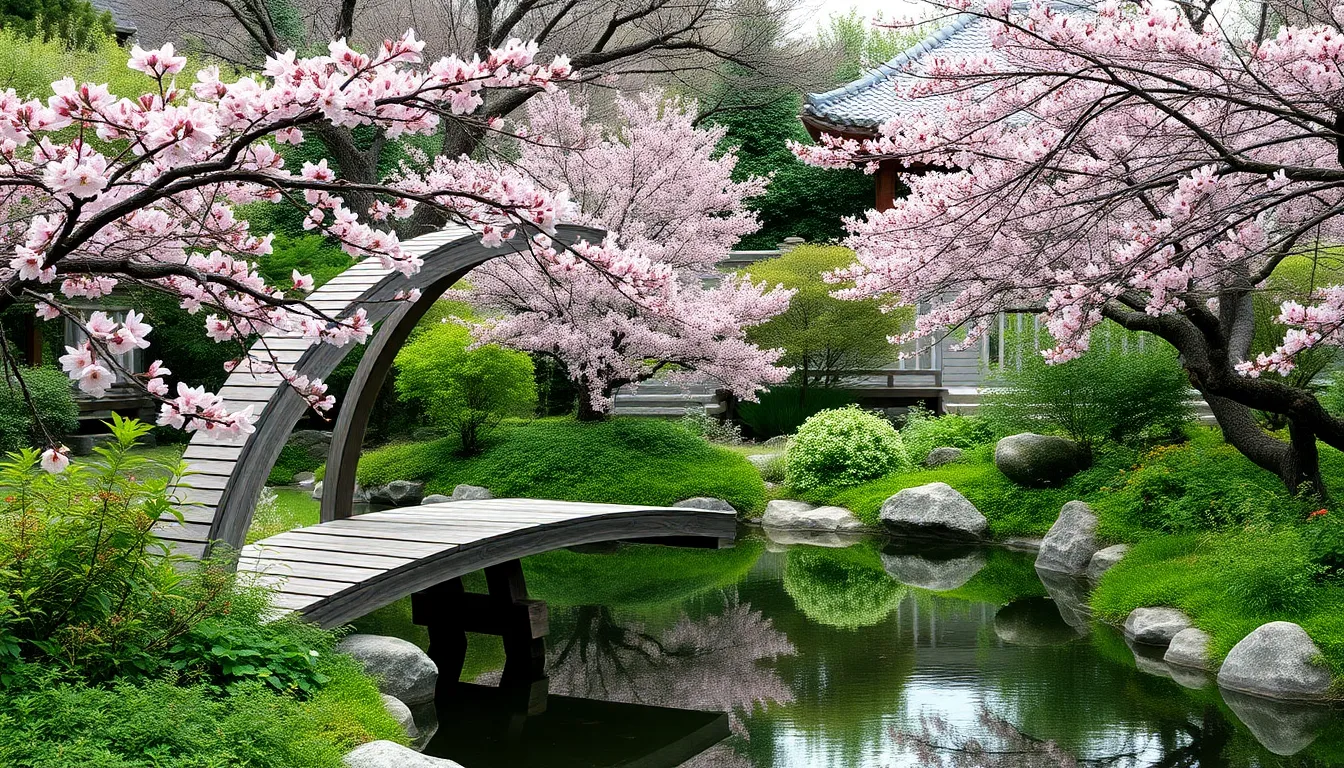
Japanese garden bridges transcend mere functionality to become powerful symbols of spiritual journey and mindful contemplation. These carefully designed structures transform our outdoor spaces into serene sanctuaries that invite peaceful reflection.
Traditional Arched Moon Bridges
Sori-hashi bridges represent the most iconic style in Japanese garden design, featuring graceful curves that mirror the moon’s reflection in water below. We call these structures “taiko-bashi” in traditional Japanese, referencing their drum-like arch that allows boats to pass underneath while symbolizing our passage from worldly concerns to spiritual awakening.
Arched wooden bridges offer timeless elegance through their simple yet refined construction, drawing inspiration from ancient Chinese designs that Japanese artisans perfected over centuries. These structures create stunning focal points in our gardens while maintaining the understated beauty that defines authentic Japanese aesthetics.
Construction considerations for moon bridges require careful attention to proportions, with the arch height typically measuring one-third of the bridge’s total length. We recommend using naturally weather-resistant woods like cedar or teak to ensure longevity while preserving the organic connection between structure and industry.
Zigzag Bridge Designs
Yatsu-hashi bridges feature distinctive eight-board layouts arranged in zigzag patterns, drawing inspiration from the classical tale found in Ise Monogatari literature. These angular pathways serve dual purposes in our gardens, creating visual interest while honoring ancient beliefs about spiritual protection.
Evil spirit deterrence represents the traditional function of zigzag designs, based on folklore suggesting that malevolent forces can only travel in straight lines. We incorporate these bridges not just for their protective symbolism but also for their ability to slow our movement through the garden, encouraging mindful observation of surrounding beauty.
Design flexibility allows yatsu-hashi bridges to work effectively over both water features and dry landscapes, making them versatile additions to various garden styles. We can construct these bridges using weathered wood planks, bamboo sections, or even stone slabs depending on our garden’s overall aesthetic vision.
Stepping Stone Bridge Concepts
Stepping stone pathways force us to slow our pace and engage more deliberately with our garden environment, transforming simple movement into meditative practice. These aren’t traditional bridges but rather intentional interruptions that heighten our awareness of each step and surrounding natural elements.
Ita-bashi plank bridges provide similar contemplative benefits through their simple, unadorned construction that emphasizes function over decoration. We use these straightforward designs to create paths across smaller water features while maintaining the minimalist principles that define authentic Japanese garden aesthetics.
Strategic placement of stepping stones requires careful spacing to ensure comfortable movement while creating natural pause points for reflection. We typically space stones 18-24 inches apart, allowing visitors to move at a contemplative pace while appreciating the garden’s carefully curated beauty from multiple vantage points.
DIY Garden Bridge Ideas for Budget-Conscious Gardeners
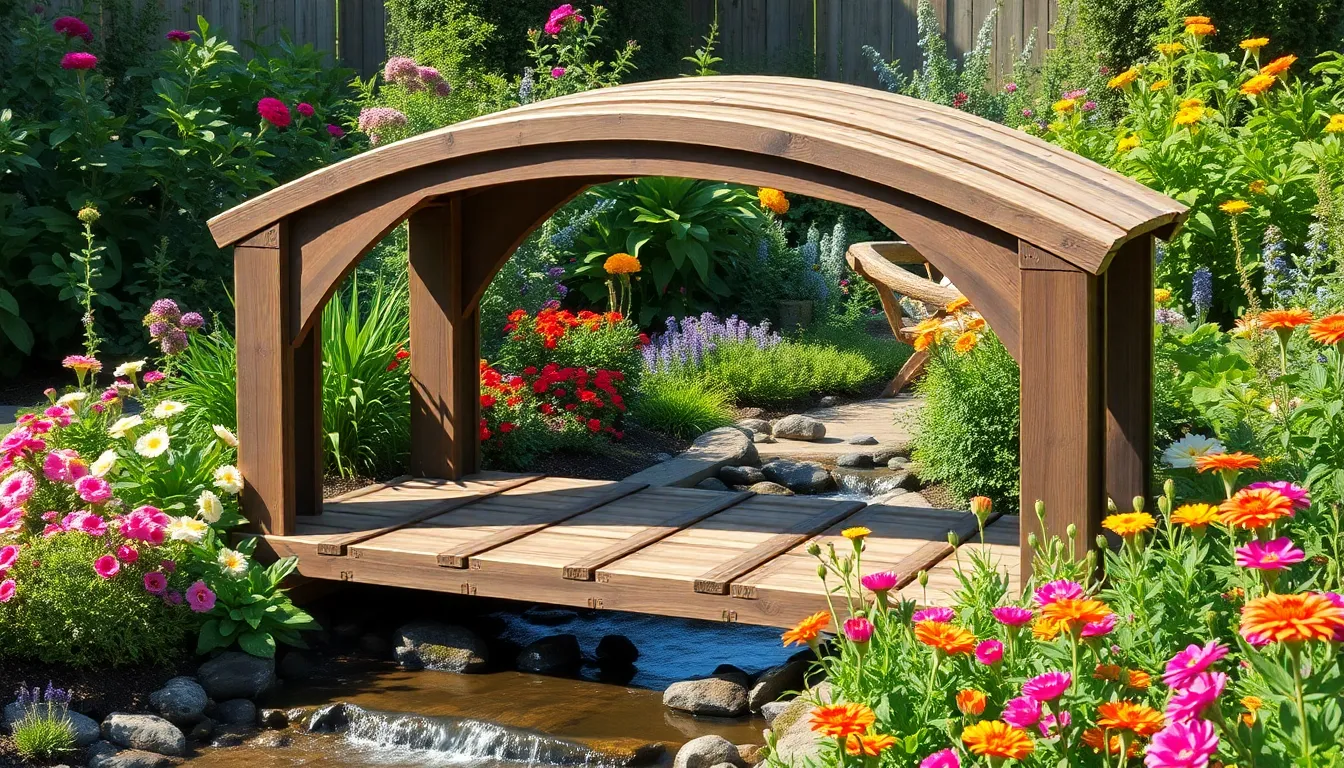
Budget-friendly garden bridges don’t require professional expertise or expensive materials. We can create stunning garden features using readily available materials and simple construction techniques.
Pallet Wood Bridge Projects
Reclaimed pallet wood offers an eco-friendly and cost-effective solution for building garden bridges. We recommend sourcing heat-treated pallets to ensure safety and durability in outdoor conditions.
Design flexibility becomes a major advantage when working with pallet materials. Simple designs can use whole pallet sections as decking, while more complex structures might require dismantling pallets for individual planks.
Construction simplicity makes pallet bridges perfect for weekend projects. We suggest treating the wood with outdoor stain or sealant to extend its lifespan and maintain its rustic appearance.
Material preparation involves sanding rough edges and checking for loose nails or splinters. Clean pallets thoroughly before construction to remove dirt and debris that could affect the finish.
Simple Plank Bridge Construction
Dimensional lumber creates straightforward bridge projects without requiring specialized woodworking skills. We can build effective bridges using 2x12s for support stringers and 2x6s for floor planks.
Foundation preparation starts with measuring the span and determining the appropriate support structure. Level ground on both sides ensures proper bridge alignment and reduces construction complexity.
Assembly process involves securing floor planks to support stringers using galvanized screws or nails. We recommend pre-drilling holes to prevent wood splitting during assembly.
Finishing touches include adding 4×4 treated pine posts for handrails when safety requires additional support. Paint or stain enhances both appearance and weather resistance for long-term durability.
Rope and Wood Suspension Bridges
Combining wooden planks with rope creates rustic suspension bridges that add adventure to garden spaces. We often find this method requires less material while delivering impressive visual impact.
Material selection focuses on pressure-treated lumber for planks and marine-grade rope for suspension elements. Steel pieces and galvanized nails provide secure connections between wooden components.
Construction technique involves cutting planks with a jigsaw to achieve desired arch shapes. We secure these curved planks using steel reinforcement pieces for structural integrity.
Decorative elements transform basic rope bridges into garden focal points. Lanterns, fairy lights, or garden statues create captivating ambiance while maintaining the bridge’s functional purpose.
Installation considerations require proper anchor points on both sides of the span. We recommend consulting local building codes for any structural requirements, especially for bridges spanning water features.
Decorative Garden Bridge Ideas with Unique Features
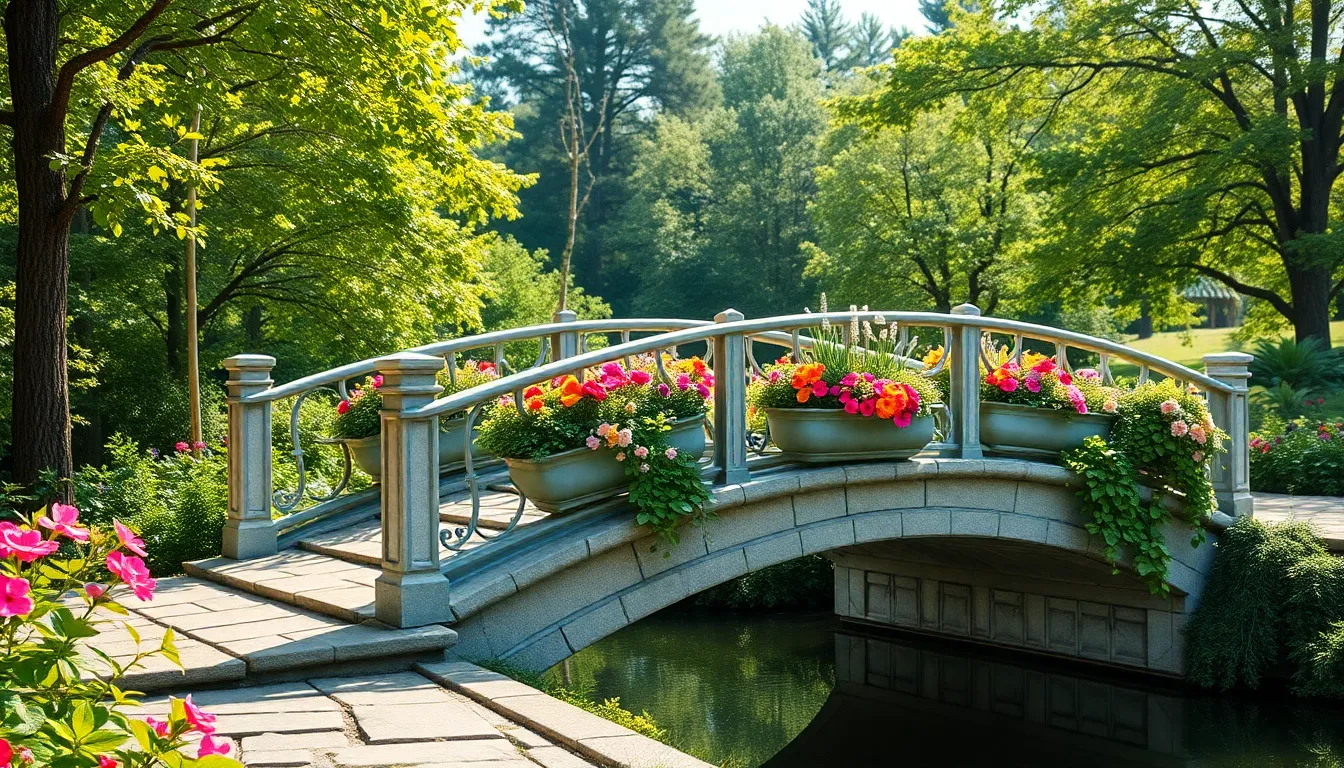
We’ve explored traditional bridge styles, but decorative garden bridges with unique features can transform your outdoor space into something truly extraordinary. These innovative designs combine functionality with distinctive elements that create memorable focal points in any industry.
Bridges with Built-In Planters
Integrated planters along bridge sides offer dual functionality as both pathway and growing space for seasonal flowers, herbs, or trailing vines. We recommend incorporating these planters into the bridge’s structural design rather than adding them as afterthoughts for better stability and visual cohesion.
Composite materials like recycled plastic, natural wood, or stone can be crafted to match your garden’s existing theme while providing durability for the planting areas. Cedar and teak work exceptionally well for wooden planters due to their natural resistance to moisture and decay.
Strategic planting choices enhance the bridge’s visual impact throughout different seasons. Consider cascading petunias, trailing ivy, or colorful nasturtiums that spill over the planter edges to soften the bridge’s appearance and create a living sculpture effect.
Drainage systems built into the planters prevent water damage to the bridge structure while ensuring healthy plant growth. We suggest installing small drainage holes and using gravel layers at the bottom of each planter compartment.
Illuminated Garden Bridge Designs
LED lighting systems installed along railings create magical evening atmospheres that highlight your bridge as a stunning focal point after dark. Small garden bridges benefit most from subtle lighting that doesn’t overpower the natural industry elements.
Solar powered lights offer energy efficient answers positioned strategically on railings or at bridge entrances for both safety and ambiance. These lights automatically charge during the day and provide gentle illumination throughout the evening hours.
Under bridge lighting techniques using LED strips can create dramatic shadow effects and highlight water features or plantings below. We recommend warm white LEDs over cool white options for a more natural and inviting appearance.
Motion activated lighting systems provide practical safety benefits while conserving energy by only illuminating when someone approaches the bridge. These systems work particularly well for longer bridge spans or areas with less foot traffic.
Bridges with Decorative Railings
Custom railing designs in arched, lattice, or cut out patterns contribute significantly to your bridge’s visual impact and overall garden aesthetic. These decorative elements can transform a simple walkway into an architectural statement piece.
Ornate metalwork railings using wrought iron or aluminum offer distinct aesthetics with exceptional durability for different garden environments. Metal railings work particularly well in contemporary or formal garden settings where clean lines are preferred.
Carved wooden railings provide warmth and natural beauty that complements rustic or traditional garden styles perfectly. Cedar and redwood are excellent choices for carved details due to their workability and weather resistance properties.
Vinyl railing systems offer low maintenance alternatives with consistent appearance that won’t require annual staining or sealing like natural wood options. These synthetic materials can mimic the look of wood or metal while providing superior longevity in harsh weather conditions.
Small Space Garden Bridge Solutions for Compact Gardens
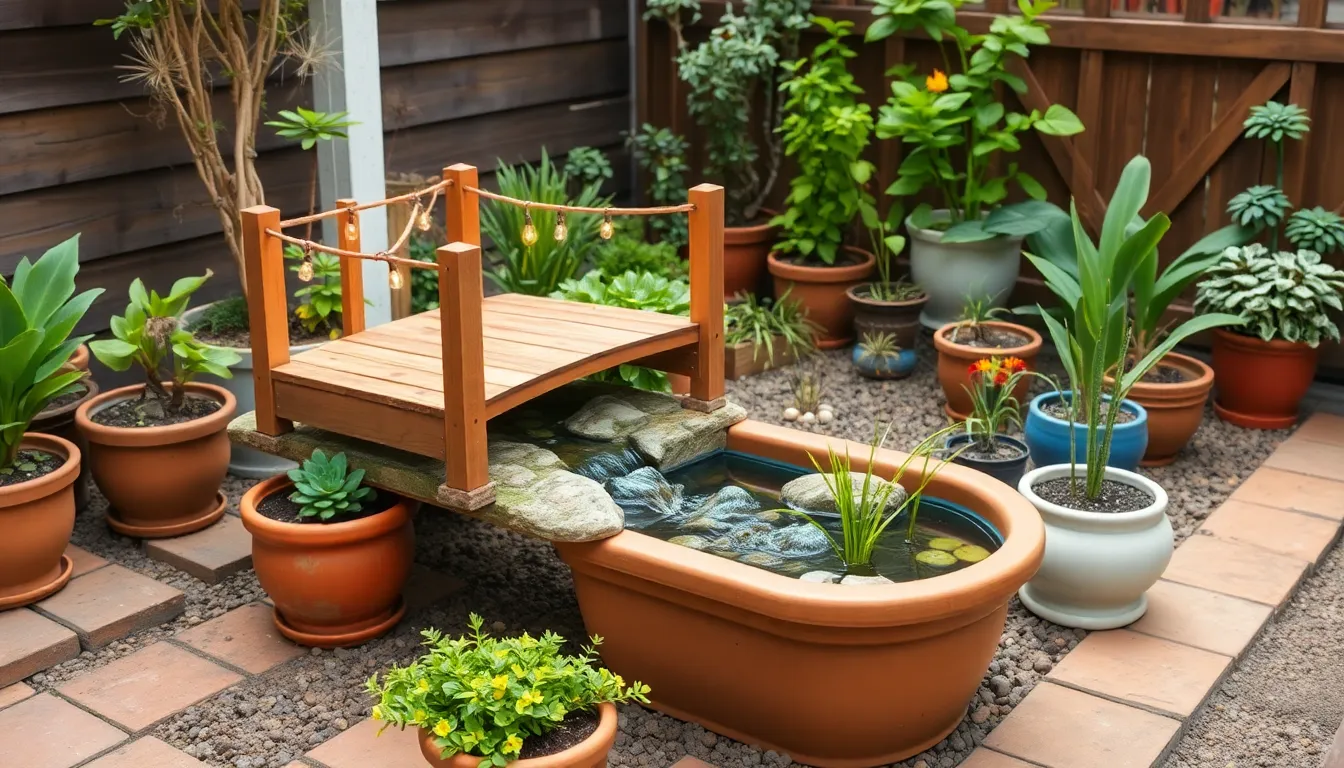
Compact gardens deserve the same enchanting bridge features as their larger counterparts. We’ve discovered that strategic design choices can maximize visual impact while working within spatial constraints.
Mini Bridge Designs for Container Gardens
Container gardens benefit from mini wooden bridges that create stunning focal points without overwhelming the space. We recommend placing these compact structures over artificial streams or shallow water features created with decorative containers.
Rail-free designs work exceptionally well in container settings since they maintain clean sight lines while adding architectural interest. These minimalist bridges complement various container arrangements without creating visual clutter.
LED lighting installation beneath mini bridges transforms container gardens into magical evening retreats. The illumination creates a surreal atmosphere that extends your garden’s appeal beyond daylight hours.
Strategic container placement allows you to design custom water features that accommodate bridge spans perfectly. We suggest using multiple containers to create flowing water effects that enhance the bridge’s purpose.
Narrow Garden Bridge Options
Treated pine and cedar materials provide optimal durability for narrow garden spaces where every element must withstand close contact. These weather-resistant woods maintain their structural integrity even in confined areas.
Custom designs become essential when working with exact dimensional constraints in narrow gardens. We recommend measuring your available space carefully before selecting or commissioning a bridge design.
Professional fabrication ensures that narrow bridges meet safety standards while maximizing the available crossing space. Custom builders can create answers that seem impossible with standard bridge designs.
Proportional scaling helps narrow bridges maintain visual harmony within confined garden layouts. The bridge should complement rather than dominate the surrounding industry elements.
Portable Garden Bridge Ideas
Modular designs offer incredible flexibility for gardeners who enjoy rearranging their outdoor spaces seasonally. These sectional bridges assemble and disassemble easily without requiring permanent installation.
Lightweight materials such as aluminum and engineered composites make bridge relocation manageable for most gardeners. We’ve found that portability doesn’t require sacrificing durability or aesthetic appeal.
Sectional construction allows you to adjust bridge length based on seasonal garden changes or evolving industry needs. This adaptability proves especially valuable in ever-changing garden environments.
Storage considerations become important with portable bridges since they need secure off-season housing. We recommend designing storage answers before purchasing to ensure proper bridge protection.
Functional Garden Bridge Ideas for Water Features
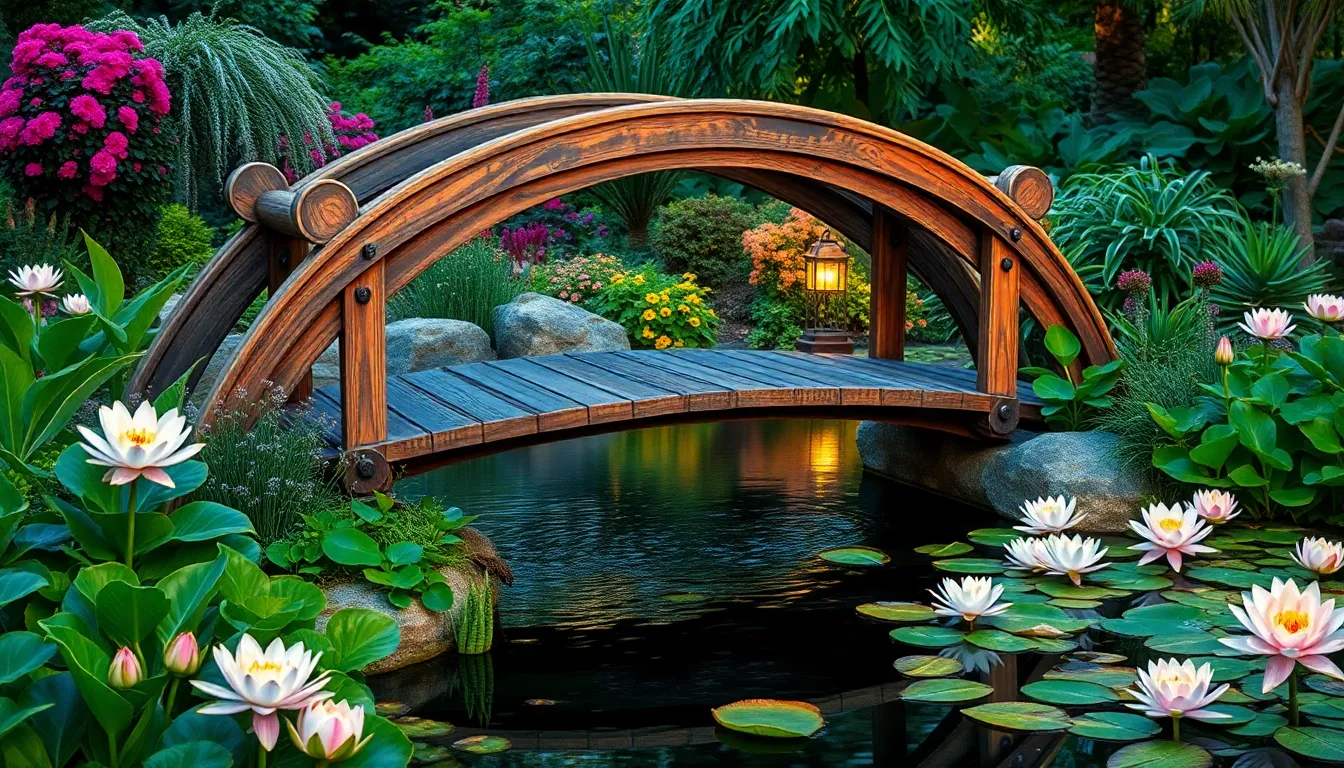
Water features and bridges create stunning partnerships that transform ordinary gardens into captivating landscapes. These combinations offer both practical crossing answers and dramatic focal points that enhance your outdoor space’s natural beauty.
Pond Crossing Bridge Designs
Pond crossing bridge designs require strategic placement over narrow sections to maintain visual balance and natural flow throughout your water feature. We recommend positioning these structures where they’ll create the most dramatic impact while preserving the pond’s organic shape and circulation patterns.
Material selection plays a crucial role in bridge longevity and aesthetic appeal. Wood offers warmth and natural beauty but requires regular maintenance to prevent wear and weather damage. Stone provides timeless elegance and exceptional durability for formal pond settings. Metal delivers modern sophistication with minimal upkeep requirements for contemporary landscapes.
Enhancement opportunities abound when framing bridges with carefully selected aquatic plants like water lilies, cattails, and ornamental grasses. Soft lighting transforms these crossings into enchanting evening features that reflect beautifully on the water’s surface. Nearby seating areas extend the bridge’s functionality by creating peaceful observation points for watching koi fish or enjoying the water’s gentle sounds.
Stream Garden Bridge Answers
Stream garden bridge answers work best when aligned with existing garden paths to create visual and functional continuity throughout your industry design. This integration ensures smooth traffic flow while maintaining the natural meandering quality that makes streams so appealing in garden settings.
Complementary features enhance the bridge’s aesthetic impact significantly. Decorative rocks positioned strategically around the bridge base create natural transitions between land and water. Small waterfalls or cascades beneath the crossing add movement and soothing sounds that amplify the sensory experience.
Ever-changing elements bring life and color to stream bridge installations. Koi fish swimming beneath the structure create mesmerizing movement patterns that captivate visitors. Floating plants like water hyacinth or lotus add seasonal color while providing natural filtration for healthier water quality.
Dry Creek Bed Bridge Concepts
Dry creek bed bridge concepts emphasize natural, rustic design elements that blend seamlessly with surrounding industry features. These installations work exceptionally well in drought prone areas or locations where permanent water features aren’t practical or desired.
Stone and wood materials maintain the natural aesthetic that makes dry creek beds so appealing in garden design. Weathered timber creates authentic rustic charm while natural stone provides structural integrity and timeless beauty. These materials age gracefully and develop character over time.
Complementary features complete the dry creek bed bridge vision effectively. Stepping stones positioned strategically along the creek bed create visual continuity and additional crossing points. Small boulders and river rocks enhance the natural appearance while providing textural interest and defining the water’s imaginary flow pattern.
Regular maintenance ensures optimal performance and longevity for all water feature bridges. We recommend inspecting structures for structural integrity seasonally and monitoring surrounding ecosystems by checking water quality and pruning plants as needed. Soft lighting installations create enchanting evening ambiance that transforms these functional elements into magical garden features.
Seasonal Garden Bridge Decorating Ideas
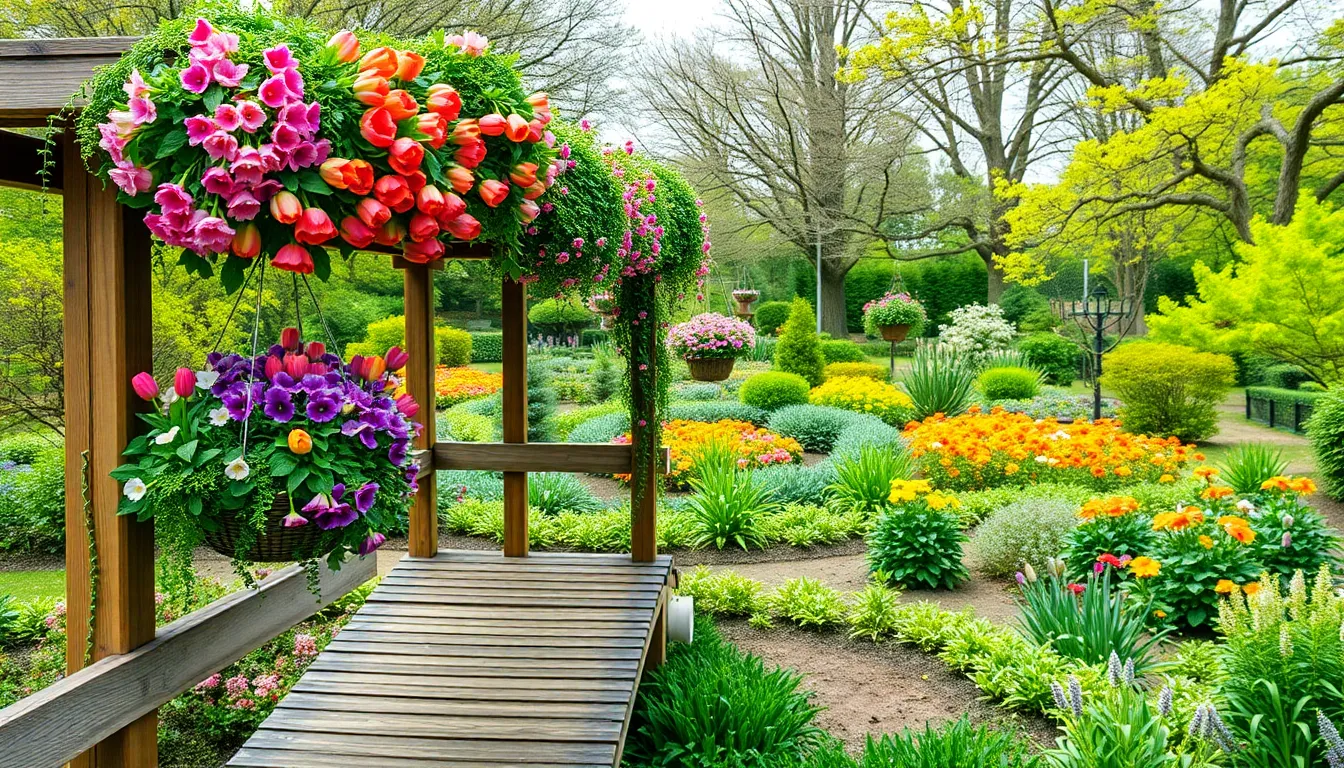
We can transform our garden bridges into stunning seasonal showcases that celebrate nature’s changing beauty throughout the year. Each season offers unique opportunities to enhance our bridge’s appeal while seamlessly integrating it with our garden’s evolving industry.
Spring Flower Bridge Decorations
Spring breathes new life into our garden bridges with vibrant blooms that herald the season’s arrival. We recommend placing pots of tulips, daffodils, and pansies along the railings to create colorful focal points that capture spring’s essence. These bright flowers provide instant charm while allowing us to easily rearrange displays as blooms fade.
Hanging baskets add vertical interest and maximize our decorating space without cluttering the walkway. We can fill these containers with vibrant annuals like petunias, impatiens, or begonias alongside trailing vines such as sweet potato vine or ivy. The cascading effect creates a living curtain that frames our bridge beautifully.
Platform decorating extends our spring display onto the bridge deck itself. We position larger planters strategically to avoid blocking foot traffic while creating mini garden vignettes. Container gardens featuring spring bulbs, primrose, and early perennials provide seasonal freshness that evolves naturally as plants mature.
Summer Vine-Covered Bridge Designs
Summer transforms our bridges into lush, living structures through strategic vine placement and climbing plant integration. We install trellises beside our bridges to support vigorous climbers like clematis, which offers abundant blooms throughout the warm months. Morning glories provide another excellent option with their heart-shaped leaves and trumpet flowers that open with the dawn.
Ivy creates a timeless, elegant appearance as it drapes naturally over bridge sides and railings. We allow these vines to develop their own flowing patterns, creating shaded pathways that offer respite from summer heat. The natural draping effect helps our bridges blend seamlessly into their surroundings while maintaining their structural visibility.
Climbing roses add romance and fragrance to our summer bridge designs. We select varieties that bloom repeatedly throughout the season, such as ‘New Dawn’ or ‘Eden’, which provide continuous color. Training these climbers requires patience, but the payoff creates an enchanting tunnel effect that transforms our bridge into a garden destination.
Fall and Winter Bridge Styling
Fall decorating celebrates the harvest season with warm, rustic elements that complement our bridge’s natural materials. We arrange pumpkins, gourds, and cornstalks along bridge edges to create seasonal vignettes that capture autumn’s abundance. These organic decorations weather naturally, requiring minimal maintenance while providing long-lasting appeal.
Potted mums offer vibrant color options in deep oranges, rich purples, and warm yellows that echo fall foliage. We group these in odd numbers for visual appeal and combine them with colorful foliage plants like ornamental kale or purple fountain grass. The varied textures create depth and interest throughout the autumn months.
Winter bridge styling focuses on illumination and evergreen elements that maintain visual appeal during dormant months. We string LED lights along railings for festive illumination that creates magical evening ambiance. These energy-efficient options withstand weather while providing year-round sparkle.
Evergreen garlands and wreaths ensure our bridges remain visually appealing even in cooler months. We use materials like pine, cedar, or fir that maintain their color and texture through winter weather. Adding red berries, pinecones, or dried seed pods creates natural accents that complement the season’s stark beauty while keeping our bridges as attractive focal points throughout the year.
Conclusion
Garden bridges offer endless possibilities to transform our outdoor spaces into enchanting retreats that reflect our personal style and vision. Whether we’re drawn to rustic wooden designs sustainable modern materials or timeless stone constructions there’s a perfect bridge solution for every garden size and budget.
The beauty of incorporating bridges lies in their versatility – they serve as both functional pathways and stunning focal points that create visual interest throughout the seasons. From DIY pallet projects to sophisticated Japanese-inspired designs we can customize these features to complement our existing industry while adding that special touch of magic.
With proper planning material selection and creative decorating ideas our garden bridges will become cherished elements that invite exploration and create lasting memories for years to come.
Frequently Asked Questions
What are garden bridges and why should I consider adding one to my outdoor space?
Garden bridges are decorative pathways that serve as both functional walkways and stunning focal points in garden design. They enhance visual interest, create adventure, and can transform any outdoor space from large backyards to small courtyards. Garden bridges don’t require water features and can be placed over dry creek beds, flower beds, or used purely as decorative elements to elevate your garden’s aesthetic appeal.
What are the most popular materials for building garden bridges?
The most popular materials include rustic wood (reclaimed barn wood, cedar logs, bamboo), modern metals (steel, iron, aluminum), and natural stone (fieldstone, concrete blocks, flagstone). Each material offers unique benefits: wood provides organic warmth, metal offers durability and sleek design, while stone delivers timeless elegance and exceptional longevity with minimal maintenance requirements.
Can I build a garden bridge myself, and what’s the most budget-friendly option?
Yes, DIY garden bridges are achievable for budget-conscious gardeners. Pallet wood bridges are the most cost-effective option, using readily available recycled materials. Simple plank bridges using dimensional lumber and rustic suspension bridges with rope and wooden planks are also accessible DIY projects that require basic construction skills and common tools.
What garden bridge styles work best for small spaces?
Small spaces benefit from mini bridge designs for container gardens, rail-free bridges for clean sight lines, and narrow custom bridges using treated pine or cedar. Portable modular bridges offer flexibility for seasonal changes. These compact solutions create stunning focal points without overwhelming limited space while maintaining functionality and visual appeal.
How do I maintain garden bridges near water features?
Regular maintenance includes inspecting for wear, cleaning debris, checking structural integrity, and applying protective finishes annually. For bridges over ponds or streams, ensure proper drainage, use weather-resistant materials, and monitor for water damage. Remove algae buildup, secure loose components, and consider seasonal decorations to maintain both functionality and aesthetic appeal throughout the year.
What are Japanese-inspired garden bridge styles?
Japanese garden bridges emphasize tranquility and mindfulness. Popular styles include traditional arched moon bridges (sori-hashi) symbolizing spiritual journeys, zigzag bridges (yatsu-hashi) encouraging mindful movement, and stepping stone concepts promoting deliberate garden engagement. These designs focus on proportional harmony, weather-resistant woods like cedar or teak, and creating reflective spaces within the garden environment.
How can I decorate my garden bridge seasonally?
Seasonal decorating keeps bridges captivating year-round. Spring features vibrant flowers like tulips and daffodils, summer showcases vine-covered designs with climbing plants, fall incorporates rustic elements like pumpkins and gourds, while winter focuses on LED illumination and evergreen accents. These seasonal touches ensure your garden bridge remains a beautiful focal point throughout changing seasons.
What decorative features can I add to make my garden bridge unique?
Unique features include built-in planters for dual functionality, LED lighting for enchanting nighttime atmospheres, and decorative railings in various artistic styles. These elements transform bridges from simple pathways into integral design features that enhance your garden’s overall aesthetic while providing practical benefits like additional planting space and improved visibility after dark.

